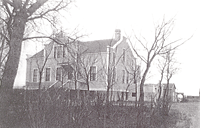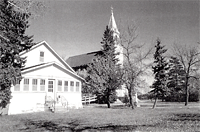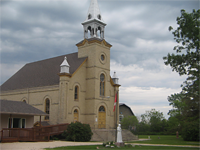Our history book “Liber Historicus – Historical glimpses Parish of St. François-Xavier - White Horse Plains 1824-1931” is now available on a USB Flash Drive (stick) for a cost of $20.00. It includes an english and french version of the book. All proceeds from these sales go directly to the parish of St. François-Xavier Roman Catholic Church. If you wish to purchase a USB, please email stfrancoisxavierparish@gmail.com.
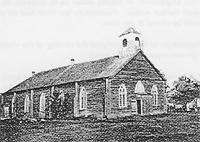
The second church of St. François-Xavier. It was built in 1832 and demolished in 1900.
From: Our First Hundred Years 1980 Municipality of St. François-Xavier
The Parish of St. François-Xavier is the second oldest Roman Catholic parish from Lake Superior to the Pacific Ocean on the western coast. We have a lot of history because we were established as a mission in 1823 by Bishop Provencher.
Saint Boniface Cathedral is Western Canada’s Mother Church. It was in 1818 that the first missionaries reached the Red River Colony, and laid the foundation of the Catholic mission that was to become the cradle of Christianity in two-thirds of this beautiful country we call Canada.
Lord Selkirk had requested Bishop Plessis of Quebec to send missionaries to serve the people. The Bishop sent Father Norbert Provencher along with Father Severe Dumoulin. After a journey of roughly 2,800 km, they arrived at the junction of the Red and Assiniboine Rivers.
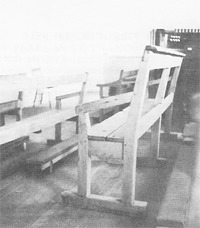
These pews from the first church of St. François-Xavier may date from 1828. Shaped by hand, they are held together by wooden dowels.
From: Our First Hundred Years 1980 Municipality of St. François-Xavier.
The day they arrived, the missionaries settled on the land chosen and given by Lord Selkirk. Father Provencher placed his apostolate under the patronage of Saint Boniface and St. François-Xavier. St. Boniface was located at the Red River and St. François-Xavier was located at Pembina.
Before the establishing of the two churches, there existed two trading posts – the Northwest Co. Trading Post and the Hudson’s Bay Company. There was always a power struggle between these two companies. The Northwest Co. Trading Post was mainly composed of aboriginals and Métis people, while the Hudson’s Bay Co. was mainly composed of Scottish settlers. The Aboriginals and Métis people used to travel throughout the land but called Pembina home, while the Scottish settlers mainly were settled around the Red and the Assiniboine Rivers.
At that time, there was a now famous leader, Cuthbert James Grant (1793-July 15, 1854) who later became known as the founder of St. François-Xavier area. His father was Cuthbert Grant Sr., a Scottish gentleman. His mother was a Métis woman of Cree and French descent from the Q’Appelle region. He was born at Fort Tremblante, Saskatchewan. His mother died when he was only 6 years old. In his early years he was sent to Scotland for his education. In 1812, when he was 19 years old, he returned to the Red River Valley. Cuthbert Grant married three times.
In 1814, he married his first wife Elizabeth McKay who gave him a son James. However, The Battle of Seven Oaks took place on June 19, 1816. To explain the Battle of Seven Oaks: armed Métis and Scottish Settlers met at a place called Seven Oaks on the banks of the Red River in what is present day Winnipeg. In a span of less than fifteen minutes, the Métis were victorious and all the Scottish settlers were dead save three. Cuthbert Grant had to go east to stand trial as a result of the Battle of Seven Oaks and when he came back, he could never find his wife and son James.
In 1820, he married a second wife, Madelaine Desmarais. They had a daughter Maria who was raised by her aunt. This union ended shortly after Maria’s birth. Maria married Pascal Breland.
In 1823, Cuthbert Grant married his third and last wife, Marie McGillis. They had 11 children. They settled on the White Horse Plains now known as St. François-Xavier Municipality. Grant became a Roman Catholic when he married Marie McGillis and he was true to his faith.
About 1821, the border between USA and Canada was established and many people unexpectedly found themselves living in the United States of America. So 2000 people followed Cuthbert Grant to Canada. They were mainly Métis along with family members. Grant did not want to establish himself at the forks, so he led the people 16 miles west of the Red River settlement on the Assiniboine River. In 1821, the two trading posts merged under the name of Hudson’s Bay Co. and the new governor, Governor George Simpson, gave Grant 23,000 acres of land which he divided into rivers lots, 12 chains wide and 2 miles long. Grant gave each family a piece of land. For many years, the settlement was to be known as Grantown. Grant died July 15, 1854 from injuries sustained after falling from his horse.
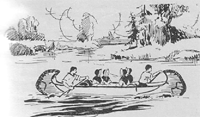
Arrival of the Grey Nuns by canoe (1844).
Frémont, Donatien : Monseigneur Provencher et son Temps Édition de La Liberté, 1935, p192a.
In the spring of 1823, Bishop Provencher established a mission at Grantown known as St. François-Xavier (sister to St. François-Xavier Church from Pembina). M. l’abbé Thomas Destroismaison was the first priest to serve intermittently at this location. By 1827, we had M. l’abbé Jean-Baptiste Harper take residence. He remained all winter long. From the very beginning, Mass was celebrated in Cuthbert Grant’s home from 1824- 1828.
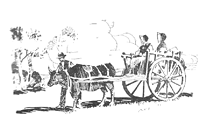
Arrival of the Grey Nuns to the prairies (1846).
Frémont, Donatien : Monseigneur Provencher et son Temps Édition de La Liberté, 1935, p192a
In 1828 the settlers built a log chapel but by 1833 it had become too small and a new chapel was constructed with Mass being celebrated for the first time at Midnight on Christmas Eve.
Bishop Provencher, concerned with the religious education of the children in the parish, asked the Grey Nuns of St. Boniface to help out. Three sisters arrived in St. François-Xavier on November 5, 1850. They were instrumental to the education of the children in the area. They also taught catechism and helped where there was a need. The Grey Nuns departed from the parish in June 1968 after 118 years of faithful service.
Parish of St. François-Xavier
In 1834, the mission of St. François-Xavier was raised to the status of a parish. Becoming a parish meant that the church kept all of their own records. That meant that all records of Marriages, Baptism, First Communion, Confirmation and burial of our parishioners were kept in our own parish registers. Before that, all records had been kept in the St. Boniface Cathedral’s registers. We still have access to these records. When St. Boniface Cathedral had a fire, these records were not completely destroyed.
On June 19, 1872, Archbishop Alexandre Antoine Taché, O.M.I., blessed our new bell. It weighed 375 pounds and cost $257.00. The bell was baptized and blessed with the name “Marie-Francois-Xavier”.
We never had a church burn down at St. François-Xavier, contrary to what is written on the Internet. Therefore, all our records are intact.
In 1873, Father Kavanagh had established three schools with 186 children in attendance. With the coming of the railway, many French Canadian families arrived and the number of schools, under the supervision of the parish, increased to five.
The second church became too old and in 1900, the present building was constructed. It was blessed December 4, 1900 by Archbishop Langevin.
In 1915, the Irish English Catholics presented two petitions to Pope Benedict XV. They were afraid that they would lose their language due to the huge French population. They asked the Pope to divide the Archdiocese of St. Boniface and requested that an English-speaking bishop be appointed to take charge of the new diocese which would include all portions west of the Red River and north of the Assiniboine River. Pope Benedict XV established the Archdiocese of Winnipeg on December 4, 1915. We are the first and oldest parish of the Archdiocese of Winnipeg, not only in Manitoba but also of all the western provinces.
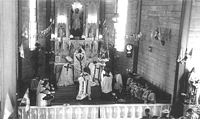
Ordination of M. l’abbé Gérard Régnier, in his birth Parish of St. François-Xavier, June 4, 1955
St. François-Xavier, Manitoba.
- from Régnier family
(Click on the images for a larger version.)

